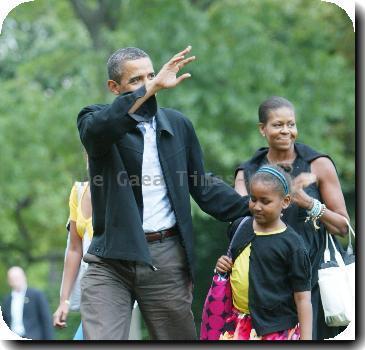Economy growing, but not enough to lower jobless rate or make Americans feel like big spenders
By Jeannine Aversa, APFriday, April 30, 2010
GDP rise not enough to make dent in jobless rate
WASHINGTON — The numbers would be excellent in normal times, but for a country recovering from deep recession, they’re not enough.
Spending by consumers rose by the fastest pace in three years, helping the economy grow at an annual rate of 3.2 percent in the first quarter of the year, the Commerce Department said Friday. It marked the third straight quarterly gain as the nation heals from the longest and deepest recession since the 1930s.
That has not been enough, however, to ignite a recovery capable of driving down the jobless rate, which has been stuck at 9.7 percent since January and is not expected to dip significantly for months.
“The recovery is slowly gaining traction, but it’s not growing fast enough now to bring down unemployment and let ordinary Americans feel like they are finally off and running,” said Mark Zandi, chief economist at Moody’s Analytics.
Economists say it takes about 3 percent growth in gross domestic product to create enough jobs just to keep up with population growth. Growth would have to be about 5 percent for a full year just to drive the unemployment rate down by 1 percentage point.
After the last severe recession in the early 1980s, GDP grew at an annual rate of 7 percent to 9 percent for five straight quarters, and the unemployment rate plunged from 10.8 percent to 7.2 percent in 18 months.
Economists don’t see anything like that happening this year or the next. In fact, growth in the first quarter was weaker than in the fourth quarter of last year, when the economy grew at a 5.6 percent rate.
Facing the prospect of 9 percent unemployment leading into the November congressional elections, President Barack Obama called the GDP report an “important milepost on the road to recovery” but acknowledged that the economy must create more jobs.
Consumers increased their spending at an annual rate of 3.6 percent in the first quarter. It was the strongest showing since early 2007 — before the Great Recession. And it marked a big improvement from the fourth quarter, when spending grew at a lackluster 1.6 percent pace.
Americans spent more on home furnishings and household appliances, recreational goods and vehicles and clothing. They also spent more at bars and restaurants.
Analysts, however, say consumers will be wary of stepping up spending much further. The high unemployment rate, sluggish wage growth and a reluctance or inability to borrow probably will limit spending, they say.
Another report Friday highlighted one of those headwinds: low wage gains for workers. Wages and salaries rose just 0.4 percent, after a 0.5 percent gain in the fourth quarter of last year.
Just 21 percent of Americans consider the economy to be in good condition, according to an Associated Press-GfK Poll conducted April 7-12.
Robert Harris, a 33-year-old father of four in Utah, said he’s spending only marginally more these days. He just bought a new cell phone and is throwing a few more items in the grocery cart. He’s spending a tad more on birthday gifts.
Still, he isn’t willing to go on any shopping sprees, even though he and his wife have secure jobs in an art department at a marketing company.
What would it take for consumers to boost their spending much higher and help catapult economic growth?
Analysts say employers would need more confidence that sales will rise enough for them to ramp up hiring and raise workers’ pay. Shoppers need to be able and willing to borrow more. And Americans need to rebuild more of their household wealth, especially equity lost from home values that tanked during the recession.
Few people expect any of those things to happen quickly. Many economists think it will take until at least the middle of the decade to lower the unemployment rate to a more normal 5.5 percent to 6 percent range.
“How will consumers behave in terms of spending in the coming months? On a scale of one to 10, I’d put it at a four,” said Richard DeKaser, president of Woodley Park Research.
DeKaser and others predict increases in consumer spending will slow to a rate of around 3 percent in the second and third quarters. That’s respectable. But it falls far short of how much consumers spent coming out of the deep recession of 1981-82.
The first quarter’s reading on GDP was a tad shy of the 3.4 percent growth rate economists were forecasting. GDP measures the value of all goods and services — from machinery to manicures — produced within the United States. It is the best gauge of the nation’s economic health.
Companies helped boost GDP by restocking inventories shrunken during the recession. Their first-quarter spending on equipment and software rose at a brisk 13.4 percent pace, after an even bigger 19 percent growth rate in the fourth quarter of 2009.
Exports grew at a slower pace in the first quarter. Imports rose much faster — reflecting stronger demand by U.S. consumers. That meant the nation’s trade deficit dragged on GDP in the first quarter. Slower export growth probably reflects less demand coming from trading partners in Europe because of the debt crisis there, analysts say.
Troubles in the real estate market slowed economic activity. Builders trimmed spending on housing projects after two quarterly gains. Spending on commercial real estate plunged at a 14 percent annual rate, the seventh straight decline.
The federal government increased spending at a 1.4 percent pace, but state and local governments continued to trim, a trend that analysts expect will continue for years.
Despite its weaknesses, the U.S. economy appears to have turned a corner. Employers are creating jobs again — a net total of 162,000 in March, the most in three years. Manufacturers are boosting production. Consumer confidence is higher.
And a rising number of companies — from Ford, Caterpillar and Whirlpool to UPS, Estee Lauder and Royal Caribbean Cruises — are seeing profits grow. General Electric says the “clouds are breaking” after having suffered one of its worst years in 2009.
Economists in a recent AP Economy Survey predict the economy will gain some speed, growing at a rate of 3.7 percent in the April-to-June quarter.
Nariman Behravesh, chief economist at IHS Global Insight, bumped up his second-quarter forecast to a pace between 4 and 4.5 percent, up from 3.7 percent. Zandi, another survey participant, is sticking with his forecast of second-quarter growth slowing to around 2.5 percent.
For 2010 as a whole, economists in the AP survey predict the economy will grow 3.1 percent. That’s an improvement from the 2.4 percent decline in 2009, the worst since 1946. But much stronger growth in the 5 percent range is needed to drive down the unemployment rate.
Tags: Barack Obama, Demographics, Economic Outlook, International Trade, Labor Economy, North America, Population Growth, Recessions And Depressions, United States, Us-economy, Washington

